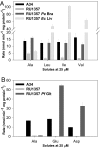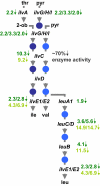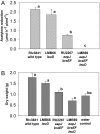Legumes regulate Rhizobium bacteroid development and persistence by the supply of branched-chain amino acids
- PMID: 19597156
- PMCID: PMC2718340
- DOI: 10.1073/pnas.0903653106
Legumes regulate Rhizobium bacteroid development and persistence by the supply of branched-chain amino acids
Abstract
One of the largest contributions to biologically available nitrogen comes from the reduction of N(2) to ammonia by rhizobia in symbiosis with legumes. Plants supply dicarboxylic acids as a carbon source to bacteroids, and in return they receive ammonia. However, metabolic exchange must be more complex, because effective N(2) fixation by Rhizobium leguminosarum bv viciae bacteroids requires either one of two broad-specificity amino acid ABC transporters (Aap and Bra). It was proposed that amino acids cycle between plant and bacteroids, but the model was unconstrained because of the broad solute specificity of Aap and Bra. Here, we constrain the specificity of Bra and ectopically express heterologous transporters to demonstrate that branched-chain amino acid (LIV) transport is essential for effective N(2) fixation. This dependence of bacteroids on the plant for LIV is not due to their known down-regulation of glutamate synthesis, because ectopic expression of glutamate dehydrogenase did not rescue effective N(2) fixation. Instead, the effect is specific to LIV and is accompanied by a major reduction in transcription and activity of LIV biosynthetic enzymes. Bacteroids become symbiotic auxotrophs for LIV and depend on the plant for their supply. Bacteroids with aap bra null mutations are reduced in number, smaller, and have a lower DNA content than wild type. Plants control LIV supply to bacteroids, regulating their development and persistence. This makes it a critical control point for regulation of symbiosis.
Conflict of interest statement
The authors declare no conflict of interest.
Figures





References
-
- Newton WE. In: Nitrogen Fixation: From Molecules to Crop Productivity. Pedrosa FO, Hungria M, Yates MG, Newton WE, editors. Dordrecht, The Netherlands: Kluwer; 2000. pp. 3–8.
-
- Oldroyd GED, Downie JA. Coordinating nodule morphogenesis with Rhizobial infection in legumes. Ann Rev Plant Biol. 2008;59:519–546. - PubMed
-
- Prell J, Poole P. Metabolic changes of rhizobia in legume nodules. Trends Microbiol. 2006;14:161–168. - PubMed
-
- Lodwig EM, et al. Amino-acid cycling drives nitrogen fixation in the legume-Rhizobium symbiosis. Nature. 2003;422:722–726. - PubMed
Publication types
MeSH terms
Substances
Grants and funding
- BB/C517025/1/BB_/Biotechnology and Biological Sciences Research Council/United Kingdom
- BB/C517025/2/BB_/Biotechnology and Biological Sciences Research Council/United Kingdom
- BB/F013159/1/BB_/Biotechnology and Biological Sciences Research Council/United Kingdom
- BBS/B/02916/BB_/Biotechnology and Biological Sciences Research Council/United Kingdom
LinkOut - more resources
Full Text Sources
Other Literature Sources
Miscellaneous

